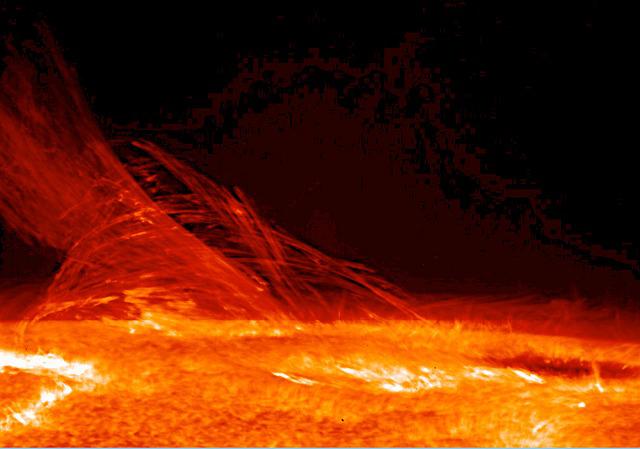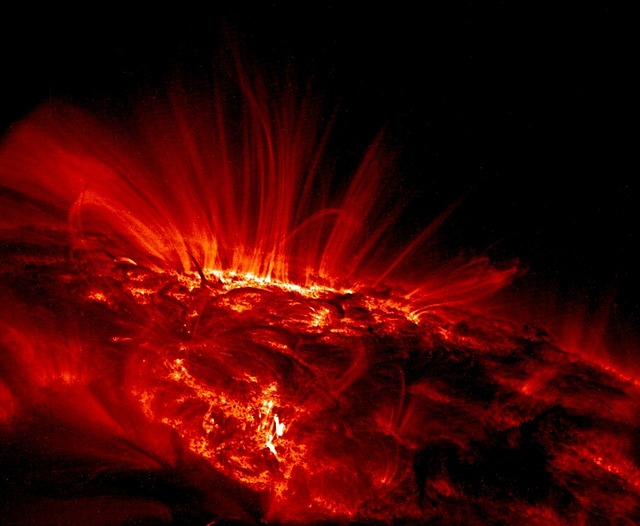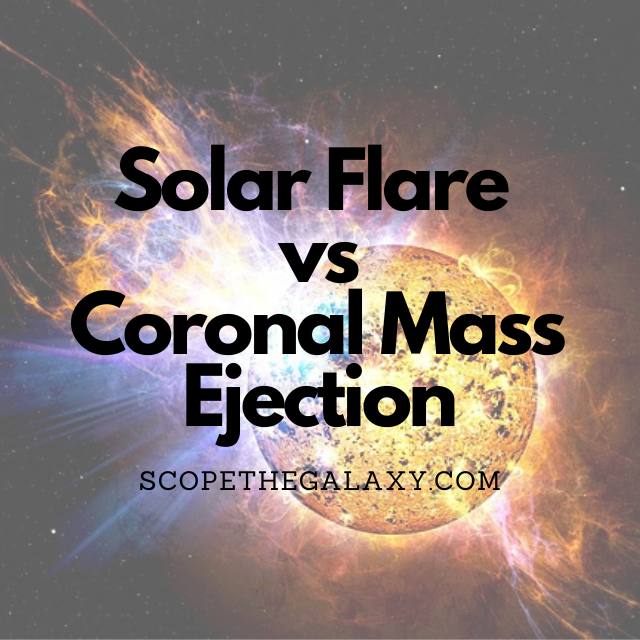*This post may contain affiliate links. This means we may make a commission if you purchase an item using one of our links*
Solar flares and coronal mass ejections are both solar explosions that burst through the surface of the Sun (often near hotspots) and make their way toward Earth. Both of these phenomena are caused by the Sun’s twisting magnetic field, which can affect technology and communications here on Earth.
Continue reading to discover the key similarities and differences between the two.
What Is A Solar Flare?
Table of Contents

Solar flares are intense radiation bursts that come from the release of magnetic energy around sunspots. These flares are among the most explosive events in our solar system, which we can see as bright spots on the Sun that last for minutes to hours.
Solar outbursts link to the 11-year cycle that is driven by the magnetic field of the Sun. Within the Sun lie electrically charged gases, which generate electrical currents. These then act as a dynamo inside the Sun and create a magnetic field that twists and turns in an attempt to reorganize itself.
The reason for the chaotic nature of the field comes from the turbulent properties of the gases that created it. And these random patterns of behavior – or “solar activity” – cause a solar flare to erupt from the Sun’s surface.
Solar flares most commonly originate from areas with high concentrations of “sun spots.” These dark and cooler areas of the Sun’s surface experience particularly strong magnetic activity, which is why they increase the chance of a solar flare. Solar flares are unlikely to occur when solar activity is low, and no sunspots are present.
According to the National Oceanic and Atmospheric Administration, there are five solar flare classes, with each class letter corresponding to a 10-fold increase in the total output of energy. The most powerful solar flares are known as X-class flares, which are ten times larger than M-class flares.
The smaller classes then go C, B, and finally, A-class, which is not strong enough to have any significant impact on Earth. X-class flares occur around ten times yearly and can affect the Earth and its satellites. Fortunately, A and B-class solar flares are the most common and relatively weak compared to M or X-class.
What Is A Coronal Mass Ejection?

A coronal mass ejection – also called a CME – is a powerful eruption from the Sun’s surface. But these explosions are relatively leisurely in nature and can travel as slowly as 250 km per second, meaning they can take several days to reach Earth.
CMEs form in a similar way to solar flares. When the Sun’s magnetic field twists and turns, it can produce strong fields that break through the Sun’s surface in active regions and create coronal mass ejections. Like solar flares, CMEs most commonly occur around groups of sunspots – the two phenomena often happen in tandem (though not always).
As a coronal mass ejection travels away from the Sun, it swells in size. Over time it can reach a length that extends almost a quarter of the total distance between the Sun and Earth. If it gets large enough and moves at greater speeds than the solar wind, it can generate a shock wave that disturbs space weather and intensifies geomagnetic storms.
But it’s not all bad – CMEs can also trigger more aurora displays at far lower latitudes than normal. The stunning light shows form disturbances in Earth’s magnetic field that concentrate ions towards the North and South poles, where they collide with nitrogen and oxygen in the atmosphere.
Coronal mass ejections can also affect electrical currents, power grids, and radio transmissions. And GPS disturbances are prevalent because they use radio signals to relay information via a satellite. But this signal must pass through the ionosphere, which is disturbed during a CME, making the coordinates inaccurate.
How Are Solar Flares And Coronal Mass Ejections Similar?
Solar flares and coronal mass ejections are both explosions on the surface of the Sun that share several characteristics and can often occur in tandem. Here are some of the key similarities between the two.
- Solar flares and coronal mass ejections form due to the Sun’s magnetic field twisting and turning in a realignment process known as magnetic reconnection.
- Both occur most often around sunspots.
- The likelihood of a solar flare or CME occurring increases when the Sun experiences periods of high solar activity within its 11-year cycle,
- An X-class or strong M-class solar flare can trigger a coronal mass ejection.
Differences Between Solar Flares And Coronal Mass Ejections
It can be easy to confuse solar flares with CMEs because they are both solar explosions caused by a shifting magnetic field – but they have quite an array of differences, which make them easy to tell apart:
- Solar flares travel much faster and reach Earth in as little as eight minutes, whereas coronal mass ejections travel far more slowly and can take anywhere from 15 hours to several days to reach the Earth.
- The slow travel time of a coronal mass ejection gives us time to plan for its arrival, but solar flares can wreak havoc because they happen so quickly.
- Solar flares look pretty different from CMEs if we observe them through a solar telescope. A solar flare appears as bright light, while a coronal mass ejection looks more like an enormous swirling cloud of gas.
- In general, solar flares impact us less and only cause temporary loss of communication signals. In contrast, a CME can mess with the balance of Earth’s magnetic fields, which has a knock-on effect on an array of human technologies.
Summary
At first glance, a solar flare seems indistinguishable from a CME; both are created from the twisting magnetic fields of the Sun, and both explode from the star’s surface and travel towards Earth. Still, upon closer inspection, we see that they are actually quite different. Solar flares travel much faster, have less impact on Earth, and look quite different from CMEs.
References
Solar flares: What are they and how do they affect Earth? | Space
Coronal mass ejections: What are they and how do they form? | Space
NASA explains difference between Solar Flares and coronal mass ejection; no effect on Earth | Tech News (hindustantimes.com)

